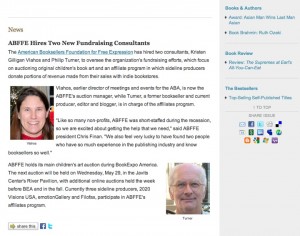Some readers of The Great Gray Bridge will recall that I ran a bookstore for many years, Undercover Books of Cleveland, Ohio, which I operated with my two siblings and our parents. I worked in the store from 1978-85, before moving to New York City and beginning to work as an editor and publisher. It was a great way to begin a career in the book business, instilling in me the passion to share my favorite books and authors with other readers. I worked as an in-house editor and publisher until 2009, when I began working as an independent provider of editorial and publishing services, which has now grown to the point where I offer quite a broad menu of services. The new role was immediately fulfilling, though I soon realized that there was something I missed about editing and publishing a full list of 20-25 books each year–that was the act and process of curation, in which I chose and sifted and assembled a coherent list.
It was with curation in mind that I started this site–I envisioned it like a garden that I would tend, a venue where I could share with friends and readers my enthusiasms for books and authors (and musicians and music, and the endless variety of urban life). I hoped it would be a very personal sort of curation, and indeed, I’ve relished doing it every day since I began the site in October 2011.
However, as a former bookseller, I sometimes felt as if something were missing–that was the opportunity to actually sell the books I was writing about it here. It could have been books I had once published, contemporary classics such as Barack Obama’s Dreams From My Father: A Story of Race and Inheritance; Edward Robb Ellis’s A Diary of the Century: Tales From America’s Great Diarist; and Peter Hopkirk’s The Great Game: The Struggle for Empire in Central Asia, or more recent titles, ones that I didn’t have a role in publishing, but which I’ve ardently recommended on this site, such as Richard Ford’s hypnotic novel Canada; James Kunen’s memoir of the recession Diary of a Company Man: Losing a Job, Finding a Life; or Dan Fesperman’s ingenious spy novel, The Double Game.
At last, I’m excited to announce that even that gap in curation will now be filled, as I have found a bookselling partner: Powell’s Books, the great independent bookstore of Portland, Oregon. As shown in Powell’s promo that I’ve placed near the upper right corner of this site, you can now click through to Powell’s website to purchase books I’ve written about that have intrigued you, or really any book at all. Please note that Powell’s stock is vast, and includes new books, as well as really hard-to-find used titles. In their partnership program, a portion of the money that Great Gray Bridge readers pay to Powell’s will then be remitted to me, which I will use to help maintain the site. It’s a win-win-win–Powell’s get a referral of new business; you get books you want to own and read; and I get to recommend books that I know you, my readers, will appreciate, while your purchases help me maintain and improve this website. As the message at the upper right corner of this site explains, you can use that little search window to look up a book, research that will take you directly to Powell’s website. In addition, from now on whenever I include book titles in a blog post, as I so often do, a click on any of those titles will reveal them to be live links that are going to take you to that book’s page on Powell’s site. See the above paragraph, as an example.
I will also be creating what Powell’s calls Partner Bookshelves, curated book lists of up to 100 titles, so please watch for those, too. In short, this is an ingenious program and I couldn’t be happier now that it’s installed and ready for use. Please note that I will be updating older posts where books are mentioned to make the titles into live links. However, this will take time, as my archive currently contains more than 540 posts published since the site began 16 months ago. So if you read an older post with a book you’re interested in and it hasn’t been updated yet, please just enter that title in the search window and a click will take you through to Powell’s website.
Thanks for trying out this new system with me. No doubt I will be tweaking it in the weeks ahead, so please let me know of any questions you may have, or suggestions, particularly if you encounter any glitches. It’s great to be back in the bookselling business!










